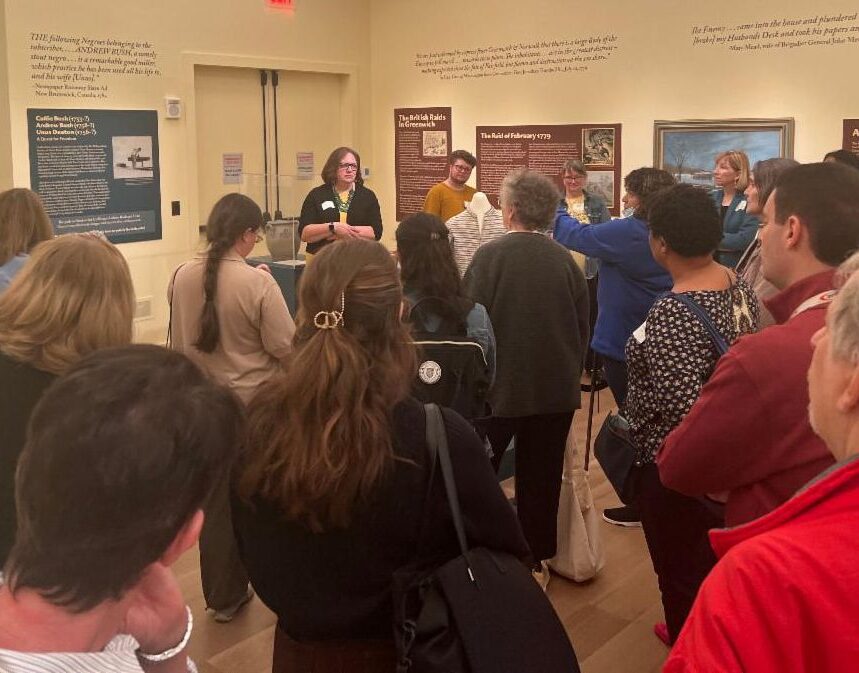Greenwich Time | March 1, 2025 | Alma Rutgers, Columnist
It’s 1775 and the Revolutionary War is about to begin. Which side would you choose?
The Greenwich Historical Society’s current exhibition — “Greenwich During the Revolutionary War, a Frontier Town on the Front Line” — begins with that question. While the answer may seem obvious in hindsight as seen through a 250-year lens, the exhibition illuminates the different life situations and choices faced by those who lived in the Greenwich area during the Revolutionary War.
The focus is on people who lived then and the choices they had to make, said curator Kathy Craughwell-Varda, who gave me a tour as I prepared to write about this exhibition that will be on view through June.
Patriot? Loyalist? Or Neutral?
Families and neighbors were divided. The Bush and Mead families of Greenwich and the Scudder, Isaacs, and St. John families of Norwalk repeatedly married among themselves and together constituted a very large extended family. One of the exhibition walls has a family tree that shows relations between members of this extended family, and in that section of the exhibition we learn about various family members and the way the war divided them.
David Bush (1733-1797) refused to sign a Patriot oath of allegiance to the United States of America and was arrested as a suspected Loyalist, a charge never proven. Bush’s youngest sister Mary was married to Capt. Matthew Mead (1734-1812), an early advocate for American Independence and a staunch Patriot. Mead, the most patriotic member of the Bush family, led his company in the Battle of Long Island in August 1776 and was with Gen. George Washington at the Battle of White Plains.
Bush’s wife, Sarah Scudder Isaacs Bush (1742-1824), spent much of the war years alone with her children. While her views are not known, at this difficult time when neighbors often suspected one another, her Patriot neighbors kept her under a cloud of suspicion.
In the year before the Revolutionary War began, Greenwich and the part of town then called Horseneck had a population of 2,788. This population included men, women, and children of European descent, free and enslaved people from Africa and the Caribbean, and local indigenous people.
The exhibition includes the information that 19 members of the extended Bush family enslaved a minimum of 70 men, women, and children. A section of the exhibition is devoted to those who were enslaved by the Bush family. This section includes Pvt. Samuel Bush (1760-1827) who enlisted in the Continental Army in 1777 and was with Gen. George Washington at Valley Forge. It is not known if he was born free or enslaved.
Enslaved people viewed the Revolutionary War’s fight for freedom through the lens of their own oppression. While for the most part without freedom of choice, some did fight on the side of the British, while others fought with the Patriots. General Washington forbade enslaved people to fight in the Continental Army but reversed position after the British offered freedom to enslaved people who fought on their side.
The British, who controlled New York City during most of the war, conducted frequent raids into Greenwich. They plundered farms and seized food, supplies, livestock, and munitions. The impact was devastating, with widespread poverty and starvation. One of the raids, famous in local folklore, was the British 1,500 troop march into Greenwich on Feb. 26, 1779, turned back after Patriot Gen. Israel Putnam rode to Stamford and returned with reinforcements.
Toward the end of the exhibition, we learn that the 13 colonies have become the United States of America and neighbors have moved beyond being Loyalists or Patriots to become Americans.
We encounter another question: What does being an American mean to you?
I indulge my personal reflections.
It’s 2025 and the authoritarian assault on America’s democracy is relentless. I choose the side of the Revolutionary War Patriots.
One of the exhibits shows Patriot soldiers and sailors toppling a statue of King George III.
“The Revolutionary War may have ended,” says the last display, “But the battle over what independence meant and who was entitled to life, liberty, and the pursuit of happiness would continue to evolve with the American experiment.”
I say: this evolving Patriot battle must continue to topple the would-be kings and dictator Loyalists.

